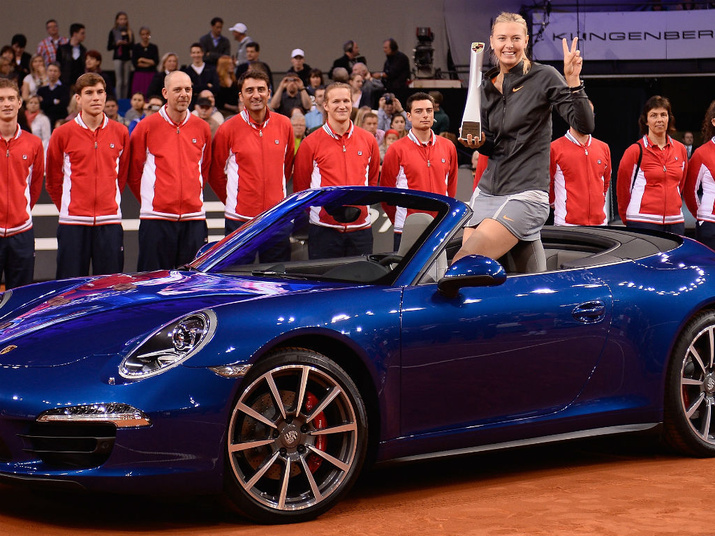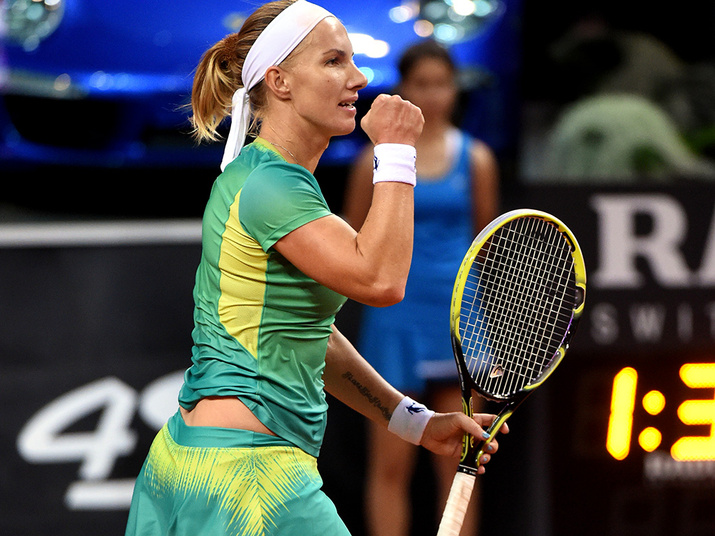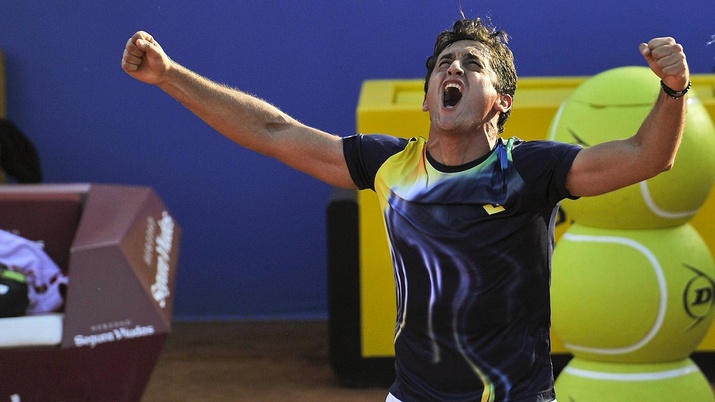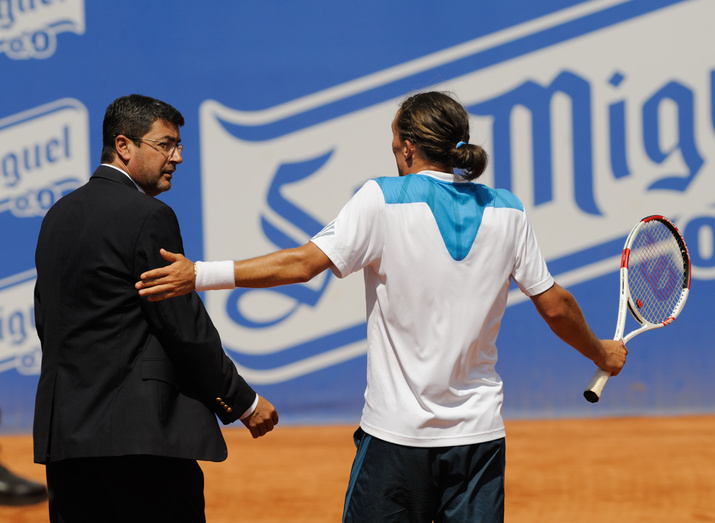Don't miss any stories → Follow Tennis View
FollowStuds and Duds: The Best and Worst in Tennis This Week
This week witnessed more momentous collisions on the women’s side than among the men. A Stuttgart Premier field stacked with elite contenders accompanied an ATP 500 event in Barcelona with only two top-10 entrants. The brisk pace of the indoor clay in Stuttgart also contrasted with the more traditional outdoor clay in Barcelona. A week of German steeliness and Spanish sun offered visual contrasts for those watching from afar.

Studs:
Maria Sharapova: Lay down a faster-than-usual clay court, put a roof over it, and what do you get? A paradise for Sharapova, who loves controlled conditions and hasn’t lost on clay to anyone other than Serena Williams since 2011. The Russian has claimed a Porsche in every color of her nation’s flag after winning three titles at the same tournament for the first time. Six of Sharapova’s 13 victories in Stuttgart have come against fellow major champions, a tribute to the quality of the field and the quality of her play there. She mounted a vintage comeback in the final from a set and a break behind, but that match was only her second-most dramatic moment of the week. The first triple-tiebreak match of Sharapova’s career saw her rally from within two points of defeat in the first round.
Kei Nishikori: The fast-rising Japanese star became the first non-Spaniard to win Barcelona since 2002 as he claimed his debut clay title. Nishikori rolled past his last two opponents in Barcelona while surrendering a total of 10 games. Although a game honed at the Nick Bolletieri Academy shines most brightly on hard courts, he showed the fitness, consistency, and baseline balance to conquer the terre battue. This ATP 500 title came at a pivotal moment for Nishikori as he consolidated a breakthrough run to the Miami semifinals, when he defeated two top-five men. His competition in Barcelona did not reach that level, but sustaining success from week to week had eluded the often-injured talent before.
Ana Ivanovic: Initially not even seeded in the Stuttgart draw, Ana Ivanovic came within three service holds of her most significant title since winning Roland Garros in 2008. She settled for her first clay final during that span after a series of victories that displayed her newfound resilience. Ivanovic improved to 6-2 this year in matches when she loses the first set while also adding her third top-10 win of the season over compatriot Jelena Jankovic. (Oddly, though, five of her seven losses this year have come after winning the first set.) Thrusting Sharapova so close to the brink at one of the Russian’s most successful tournaments also counted as a moral victory for a player so reliant on confidence.
Unseeded Russians: The road has been predictably long and winding for Alisa Kleybanova in her second career. No adversity on the court must intimidate Kleybanova at this stage, however, having overcome Hodgkin’s lymphoma. She notched her first top-10 win since her recovery by ousting Petra Kvitova in Stuttgart, where she reached the first Premier quarterfinal of her comeback.

One of her compatriots, Svetlana Kuznetsova, shone just as brightly by earning her first top-five win since Roland Garros in 2012. While Kuznetsova had not suffered a setback on the scale of Kleybanova, injuries had limited her to just two victories in 2014. The former Roland Garros champion doubled that total in Stuttgart before challenging Ivanovic deep into the third set of their quarterfinal.
Off to his best start of a season ever, Teymuraz Gabashvili reached his second ATP quarterfinal of the season in Barcelona. This ball-bruiser has spent most of his career ricocheting around the Challenger Tour, qualifying draws, and the least significant ATP events. In Barcelona, however, Gabashvili earned three straight-sets wins that should catapult him into the top 50 on Monday. His upset over David Ferrer marked his first over a top-10 foe in nearly four years.
Bucharest finalists: Having achieved little since winning the Bucharest title last season, Lukas Rosol revived memories of that moment by reaching a second straight final there. But the defending champion fell prey to another man who won his first clay title. Top seed Grigor Dimitrov raced through the week without dropping a set, of which he played only seven following a first-round bye and a semifinal retirement. Dimitrov has struggled with playing to the level of the competition early in his career, so his dominance marked a step forward.
Marrakech finalists: An all-unseeded final unfolded at the WTA’s only tournament in Africa. Each woman had knocked off two seeds en route to the final, fully earning her opportunity. Maria-Teresa Torro-Flor collected her first career title by outlasting Romina Oprandi in a three-set rollercoaster.

Nicolas Almagro: There was nothing “Almagro-esque” about his valiant comeback from losing the first set to Rafael Nadal, a man whom he never had defeated. The 20th-ranked Spaniard also showed startling poise in rebounding from an early deficit in the final set. Almagro fired a furious barrage of winners when the match hung in the balance, although he also received some help from Nadal (see below). Unfortunately, his ensuing loss to an unseeded opponent was all too “Almagro-esque.”
Dominic Thiem: The 20-year-old talent from Austria reached the third round of an ATP tournament for the second time this spring. As he did at Indian Wells, Thiem qualified for the main draw in Barcelona. He scored a notable three-set victory there over Marcel Granollers, a home hope with plenty of clay experience. Thiem’s steady rise has shown discipline and consistency, valuable assets in a young player.
Novak Djokovic: As his wrist heals, the world No. 2 announced that fiancée Jelena Ristic and he will welcome their first child this year. Fans will be intrigued to see the impact of this momentous event on Djokovic’s career and overall outlook.
Duds:
Top two Barcelona seeds: A first loss for Rafael Nadal in 11 meetings with Nicolas Almagro—on clay, in Spain—stunned all who watched. Last Friday also marked Nadal’s first setback in Barcelona since his debut there in 2003, snapping a streak of 41 straight victories, and his first clay loss after winning the first set in 154 matches since 2007. This cluster of firsts comes at a particularly ominous moment for the world No. 1, a week after David Ferrer bounced him almost routinely from Monte Carlo, where he also has won eight titles. Two quarterfinal losses in two weeks at two of his most prolific tournaments to two compatriots whom Nadal had dominated on clay? Toss in Djokovic’s wrist injury, and the men’s road to Roland Garros looks foggier than it has in nearly a decade.
At one time, the thought of David Ferrer alternating stirring triumphs with staggering losses seemed as implausible as the thought of…Ferrer upsetting Nadal on clay? That happened last week in Monte Carlo, just days before an opening-round exit happened this week in Barcelona. In a season defined by twists and turns, it is fitting that the ATP bastion of consistency should veer wildly from one extreme to another.
Fabio Fognini: With a higher status come higher expectations, not just in results but in character. The third-seeded Fognini fell well short of those expectations by retiring at 0-6 0-4 in Barcelona. His vague explanation blamed fatigue rather than a serious injury. Most would agree that fatigue is no reason to avoid playing two extra games.

Alexandr Dolgopolov: His exploits on spring hard courts have not translated to clay, despite Dolgopolov’s experience on the surface while growing up in Ukraine. One early exit in Monte Carlo preceded another in Barcelona against 33-year-old clay specialist Albert Montanes. His loss highlighted the dissonance between the volatile unpredictability of his game and a surface that rewards consistency.
Top WTA lefties: German women in Stuttgart gave their home fans little to cheer this week, including fourth seed Angelique Kerber. A loss to clay specialist Carla Suarez Navarro was not a stunning setback, however, since Kerber produces her least convincing tennis on this surface.
For the third time in seven tournaments this season, Petra Kvitova exited in the opening round. A vast quantity of fall points will insulate her ranking for weeks or months to come, giving the world No. 6 breathing room to rediscover her form. But underdogs should exhale if they land in Kvitova’s section at this spring’s marquee events.
Simona Halep: She dropped her first WTA match as a top-five player, just as she dropped her first WTA match as a top-10 player in February. The small Halep may have arrived in Stuttgart with her energy depleted, having played two Fed Cup play-off matches in Romania over the previous weekend.
Francesca Schiavone: The defending champion in Marrakech fell in the first round of the WTA’s only tournament in Africa. Schiavone has left her peak period several years behind her, and the points lost this week will thrust her only further beyond the fringes of relevance.










